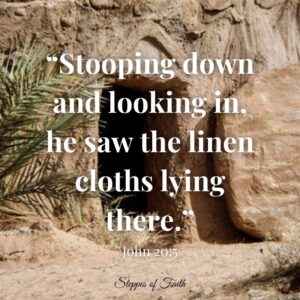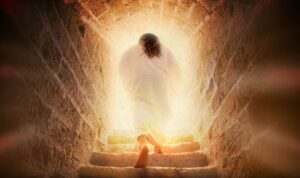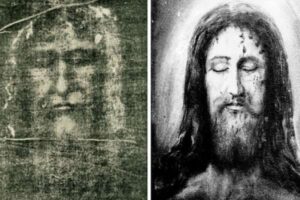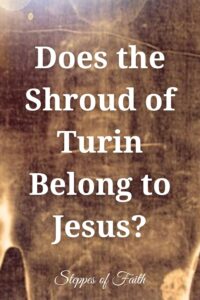
“Stooping down and looking in, he saw the linen cloths lying there.” (John 20:5)
One of the most controversial pieces of biblical archaeology is the Shroud of Turin. No artifact seems to drum up more debate and study, stir the imagination, and (for some) fortify faith than a large piece of cloth supposedly imprinted with Jesus’ image. But does the shroud genuinely belong to Him or someone else? While there is no conclusive evidence to either side of the argument, we can refer to the Scriptures as we examine the shroud in more detail.
The Shroud of Turin is a large, intact linen sheet that bears the front and back images of a man who apparently had been crucified in typical Roman fashion. Through much studying, researchers determined that the man had been severely injured, much in the same way as the gospels record Jesus’ crucifixion. The man appears to have had his hands, feet, and side pierced like Jesus, and his legs were not broken, as written in John 19:33.
“But when they came to Jesus and saw that He was already dead, they did not break His legs.”
Other physical features indicate the man on the shroud is naked with his hands folded across his pelvis. He is apparently bearded and measures about 5 feet 10 inches (1.78 meters) to 6 feet 1 inch (1.85 meters) in height.
The image on the shroud is said to be only two fibrils deep, which makes the image difficult to see aside from an outline of the man’s body. However, when one views a photograph of the shroud, the photo negatives reveal a prominent image, one that allowed Ave Maria University in Boston, Massachusetts, to create a three-dimensional reconstruction of the man in 2023. Jerusalem’s Notre Dame Center also houses a three-dimensional recreation.

The Shroud of Turin may not be unique, however. A similar shroud called the Mandylion was discovered in 525 A.D. in Edessa, an early Christian town in modern-day eastern Turkey. Considered by historians to be a sacred relic from Constantinople, the Mandylion is also said to bear an image of Jesus’ face and is the actual shroud from His tomb. Two other shrouds—the Veil of Veronica and the Camouliana—also claim to be shrouds of Jesus’ face.
Despite these claims, many scientists believe that the Shroud of Turin is the correct cloth belonging to Jesus.
The Shroud’s History
Who discovered the Shroud of Turin remains a mystery. First appearing in France in the 1350s, the original owner died without revealing how he came into its possession. Who owned the shroud after his death is unknown, but forensics reveals that it sustained fire damage in 1532. Twenty-five years later, the Cathedral of St. John the Baptist in Turin, Italy, took ownership, where it still remains.
Since the first photograph of the shroud in 1898, researchers in multiple scientific disciplines have written hundreds of books and articles about it. Called sindonologists (from the Greek word sindōn to define Jesus’s burial cloth), they support the shroud’s authenticity, as do those in religious circles. But not everyone agrees with them.
Historians have investigated the shroud but can only guess the events occurring between the first and sixth centuries when they first entered the historical record. Up to that point, no one had looked for the shroud. After that, a series of burial cloths began to appear all claiming historical references to Jesus.
Because of the gap in chronological time, historians tend to believe the shroud is a medieval forgery. In addition, archaeological assessments of the linen cloth and studies of first-century Jewish burial practices suggest it is a relic from the Middle Ages.
Perhaps the strongest argument against its authenticity came in 1988 when scientists at three different laboratories conducted carbon dating testing. They all concluded that the shroud originated sometime between 1260 and 1390 A.D., well after Jesus’ resurrection. Since then, the Catholic Church has not allowed any additional examinations of the shroud.
Shroud Features and Ancient Connections
However, the Shroud of Turin contains many interesting features that seem to point to Jesus.
As one intact cloth, the shroud measures 14 feet 3 inches (4.34 meters) by 3 feet 7 inches (1.09 meters). It bears many unique features, including purple stains, which many researchers attribute to blood.
Traces of flogging by a flagrum (a “cat of nine tails,” except it likely had three) are evident. March 15:16-20 records that the Romans flogged and tortured Jesus the morning of His crucifixion. A flagrum consisted of long leather thongs embedded with barbs, sharp pieces of iron, lead balls, or sheep bones. An exceedingly cruel Roman device, the flagrum would tear out pieces of flesh, sometimes down to the bone, when used. The image on the shroud shows over 100 clear markings, possibly caused by a flagrum(s).
Evidence of severe abrasions is evident on the man’s shoulders. Some speculate that the marks were caused by carrying a crossbar of a cross for a long distance, which was common in a Roman execution. One did not carry an entire cross, only the crossbar. The post of the cross continually remained in the ground for repeated use because suitable wood was scarce and expensive.
READ MORE: The Science of Crucifixion: Why Was the Cross Necessary?
Studies focusing on the shroud’s date appear to show evidence of soil and pollen in the fibers common to Israel in the first century. The evidence is not conclusive, however.
Scientists and religious teachers assert that Jesus created the shroud’s image at the moment of His resurrection. They hypothesize that His body radiated a glorified energy that embedded His image onto the shroud.
Science seems to support the shroud’s validity even if history does not. But what does the Bible say about it?

What the Bible Says
Though many Christians believe the Shroud of Turin is Jesus’ actual burial cloth (particularly those in the Catholic Church), the Bible seems to indicate otherwise.
The New Testament gospels record that Joseph of Arimathea, a member of the Sanhedrin (Jewish council of religious leaders), asked Pontius Pilate for Jesus’ dead body, wrapped Him in linen, and buried Him in his private tomb (Mt 27.59; Mk 15:46; Luke 23:53).
Some scholars speculate Joseph used the cloth only to transport Jesus’ body to the tomb. Once there, he likely cleaned the body and rewrapped it in new cloth, according to typical Jewish burial practices. However, the Bible presents better evidence in Luke 24:12 and John 20:5-7.
“But Peter arose and ran to the tomb. And, stooping down, he saw the linen cloths lying by themselves.” (Luke 24:12)
“And [John], stooping down and looking in, saw the linen cloths lying there; yet he did not go in. Then Simon Peter came, following him, and went into the tomb, and he saw the linen cloths lying there.” (John 20:5-6, my addition)
Notice that Luke and John both record the two disciples seeing linen cloths (plural). To add to the argument against the shroud’s legitimacy, John goes on in verses 7-8 to say that they found a third cloth in the tomb.
“And [they saw] the handkerchief that had been around His head, not lying with the linen cloths but folded together in a place by itself. Then the other disciple, who came to the tomb first, went in also, and he saw and believed.” (my addition)
Remember that the Shroud of Turin is one piece of cloth, yet Scripture tells us that Joseph likely wrapped Jesus in three separate cloths, one that was somehow neatly folded after Jesus’ resurrection. Because of these Scriptures, the claim that the shroud belongs to Jesus would appear inaccurate.
Just an Average Guy
Naysayers base another argument refuting the shroud’s validity on the estimated height of the man on the shroud. Evidence shows he was approximately 5 feet 10 inches to 6 feet 1 inch (1.78-1.85 meters) tall. A typical man’s height in first-century Israel was an average of 5 feet 1 inch (1.55 meters). Had Jesus been up to six feet tall, He would have stood at least one foot taller than anyone else.
The Bible does not say much about Jesus’ physical appearance, but Isaiah 53:2 gives us a helpful clue.
“He has no form or comeliness. And when we see Him, there is no beauty that we should desire Him.”
According to Isaiah, Jesus was just an average guy. He was not exceptionally handsome or tall; He was just an ordinary man who looked like other men of His day. Had He been as tall as the man on the Shroud of Turin, He would have been easily recognizable and perhaps more highly desirable since many regard height with greatness in some manner.
But Isaiah says Jesus looked much like the other men in Israel, likely including being the average height of about 5 feet 1 inch (1.55 meters). Such an observation indicates the image of the man in the Shroud of Turin is not that of Jesus.

To See or Not to See
One might make a third argument that the shroud is not authentic because it depicts Jesus’ face. As the Son of God and, therefore, God, only those alive during His earthly lifetime could have seen Him.
God commands that no one may see His face many times in Scripture. God hid His face from Moses by calling to him from a burning bush (Ex 3). He hid His face from Moses again when he asked if he could see God’s glory. God consented, but He hid Moses in the cleft of a rock.
“But [God] said, ‘You cannot see My face, for no man shall see Me and live.’ And the LORD said, ‘Here is a place by Me, and you shall stand on the rock. So it shall be, while My glory passes by, that I will put you in the cleft of the rock and will cover you with My hand while I pass by. Then I will take away My hand, and you shall see My back, but My face shall not be seen.’” (Ex 33:19-23, my addition)
God also hid His face from the prophet Elijah in 1 Kings 19:11.
“Then He said, ‘Go out and stand on the mountain before the LORD.’ And behold, the LORD passed by, and a great and strong wind tore into the mountains and broke the rocks in pieces before the LORD, but the LORD was not in the wind.”
John 1:18 confirms that no one may see God’s face in the New Testament.
“No one has seen God at any time. The only begotten Son, who is in the bosom of the Father, He has declared Him.”
Though one could see Jesus’ face at the time of His earthly life, He was only a representation of the Father, according to John 1:18. Given these Scriptures, one might conclude that God would not allow any physical representation of Him to remain after Jesus’ resurrection. To do so could open a door to worship of a relic rather than the living God.
The Shroud’s Reminder
Arguments for and against the Shroud of Turin continue among many groups—scientists, historians, politicians, authors, theological scholars, laymen, filmmakers, and neighbors. Some say it is real, while others assert it is nothing more than an old relic that persists in medieval superstition. Regardless, its relevance has withstood the changing times.
Whatever one believes, the Shroud of Turin should remind believers of the sacrifice Jesus made for us. He paid the sin debt we owe by dying on the cross in our place. Three days later, He rose from the grave to defeat death’s grip. May the shroud inspire us to worship our Lord and Savior, Jesus Christ, not an ancient piece of cloth.

The objection of plural cloths is easily answered: There were 2 cloths plus the headcloth.
The Shroud / the winding strip which was about 14 feet long to keep the Shroud on the body was later re-sewn back onto the Shroud. This seam is clearly seen today running from end to end /. and of course the headcloth. 3 items